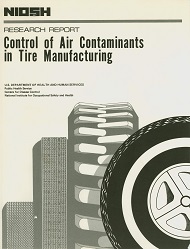Control of Air Contaminants in Tire Manufacturing
May 1984
DHHS (NIOSH) Publication Number 84-111

The control of air contaminants in tire manufacturing factories (SIC- 2822) is reviewed. Controlling air contaminants decreases worker exposure to pollutants. An overview of occupational exposures from tire manufacturing operations is outlined. The engineering control strategy is summarized. General work practices and recommendations to improve conditions or to minimize hazards are discussed. The observed importance of work practices is described. Challenges in the implementation of proper work practices are discussed. Results of 13 preliminary surveys in tire manufacturing factories, particularly in different areas of processing, compounding, banbury loading, milling and curing, and tread cementing are outlined. Limits are set by NIOSH and are given as time weighted averages for occupational exposure to the air contaminants benzene (71432), carbon-black (1333864), heptane (142825), hexane (110543), pentane (109660), toluene (108883), xylene (1330207), talc(14807966), alkanes with five to eight carbons, rubber solvent, nuisance dust, asbestos (1332214), petroleum distillate, and refined petroleum solvents. These values are compared with values set by OSHA and other government agencies. The authors conclude that adherence to recommendations made to improve worker practices and operations to maintain NIOSH standards will reduce worker hazards in tire manufacturing factories.
